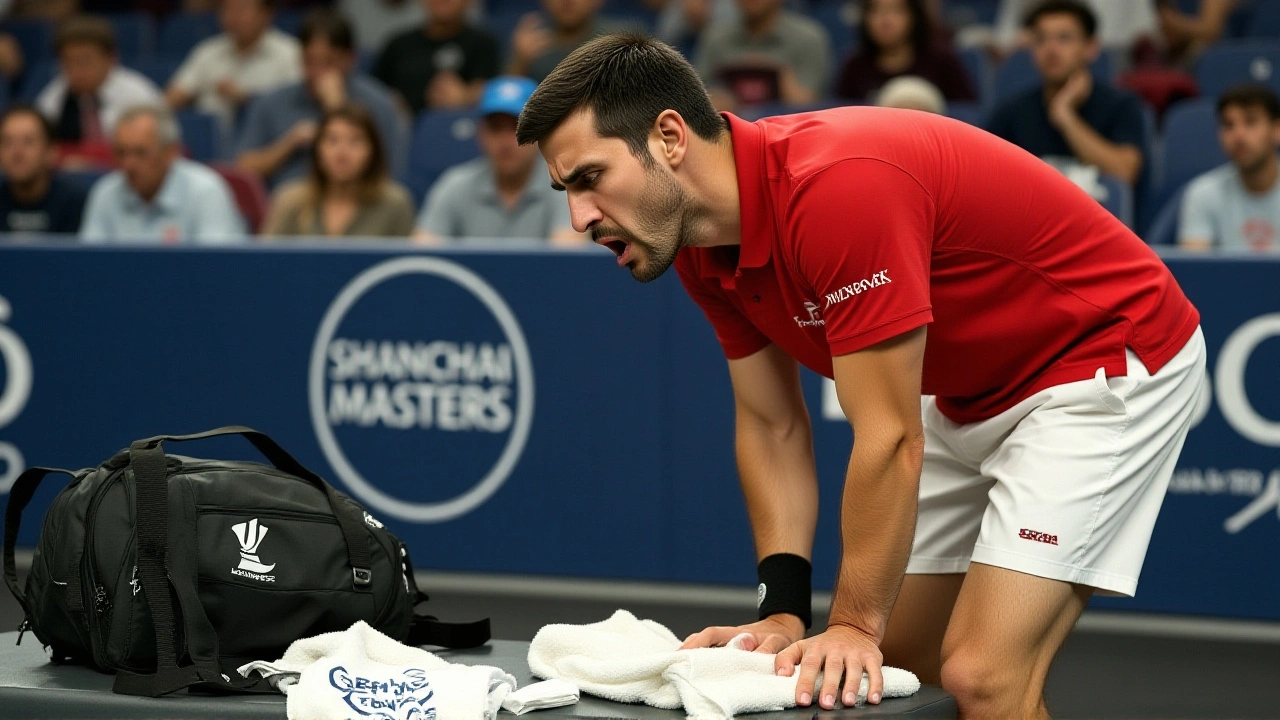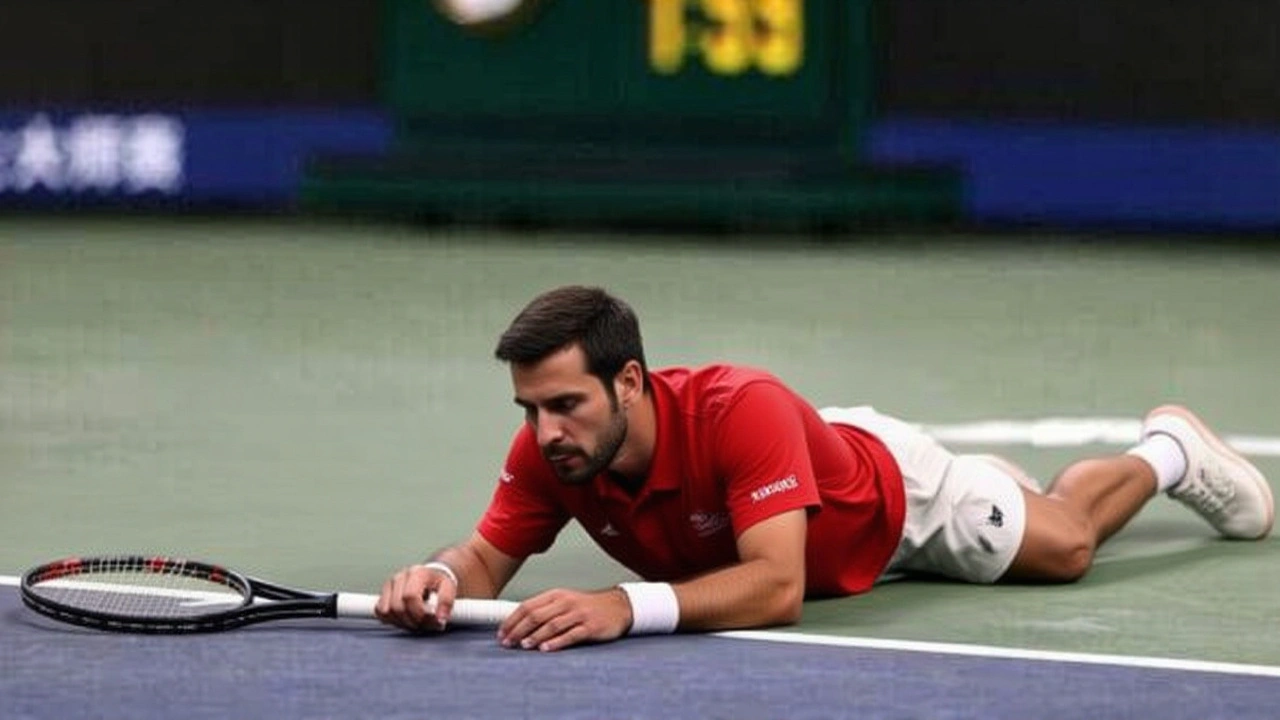Novak Djokovic collapses in Shanghai heat, makes Masters history

When Novak Djokovic, a 38‑year‑old Serbian professional tennis player went down on the court during his round‑of‑16 clash with Spain’s Jaume Munar, the whole tennis world took notice. The drama unfolded on Tuesday, 7 October 2025, at the Shanghai Masters Qi Zhong Stadium, China, where temperatures hovered around 30 °C and humidity peaked at 80 %.
Here’s the thing: Djokovic fought back after a brutal first set, won it 6‑3, then a grueling second set slipped away 5‑7, before clinching the decider 6‑2. In the middle of that second set, the Serbian star vomited, crouched repeatedly, and finally collapsed at 3:47 PM China Standard Time. Medical staff checked his vitals, gave a five‑minute timeout, and he somehow steadied enough to finish the match. The win made him the oldest player – at 38 – to reach a quarter‑final in an ATP Masters 1000 event.
Heat and health: why the conditions mattered
The Association of Tennis Professionals (ATP) schedules the Masters 1000 series as the pinnacle of men’s tennis outside the Grand Slams. Yet even the ATP’s heat‑policy guidelines struggled to keep up with Shanghai’s sweltering autumn. Players reported feeling light‑headed, and the open retractable roof offered no respite.
- Temperature: 30 °C (86 °F)
- Humidity: 80 %
- Match length: 2 hours 41 minutes
- Scoreline: 6‑3, 5‑7, 6‑2
- Age record: 38 years – oldest Masters 1000 quarter‑finalist
Scientists say that at those humidity levels, sweat evaporates far slower, dramatically raising core body temperature. For a player dealing with a lingering left Achilles issue – which Djokovic received treatment for early in the match – the extra strain was enough to tip the balance.
Other players feel the heat
Djokovic wasn’t the only one who paid the price. British talent Emma Raducanu collapsed during a separate event in China, prompting concerns about the broader impact on both men’s and women’s tours. Australian No. 1 Alex de Minaur was slated to face Portugal’s Nuno Borges the next day, hoping to secure his own quarter‑final spot amid the oppressive conditions.
Fans described the stadium’s atmosphere as “oppressive,” with many spectators fanning themselves with programs while the players battled dehydration. The tournament’s director declined to comment publicly, but insiders said the decision to keep the roof open was partly driven by broadcast commitments.
Reactions from the tennis community
After the match, Djokovic posted on X, writing, “Tough day at the office. Very challenging physically. Luckily, I have the greatest support in the world.” The tweet amassed over 150,000 likes within two hours, underscoring both the drama and the concern fans felt for his wellbeing.
Former world‑number‑one Andre Agassi, now an ATP board member, said, “We have to rethink heat protocols. Players deserve safe conditions, not a test of endurance.” Meanwhile, sports‑medicine experts pointed out that the ATP’s current rule – allowing play unless a player is outright incapacitated – may need tightening.

What this means for future tournaments
Organizers of the 2026 edition are already exploring options: more frequent cooling breaks, mandatory hydration stations, and possibly a schedule shift to evenings when temperatures dip. If the ATP adopts stricter standards, we could see a ripple effect across all outdoor events, from the US Open to the Australian Open’s early‑season heat.
For Djokovic, the immediate concern is recovery. His medical team will likely run a battery of tests to assess the Achilles strain and any heat‑related complications. A return to full fitness could affect his Wimbledon preparations, where the grass courts bring their own set of physical demands.
Key takeaways
In short, the Shanghai Masters served as a stark reminder that climate change isn’t just a future problem – it’s influencing sport today. Players, organizers, and fans alike are forced to reckon with the reality of competing in conditions once considered “just a bit hot.”
Frequently Asked Questions
How did Novak Djokovic’s collapse affect his chances at Wimbledon?
Djokovic’s medical team will monitor his recovery closely. If the Achilles issue and heat‑related fatigue are resolved, he could still be a contender at Wimbledon, though any lingering weakness might force him to adjust his training schedule.
What heat‑policy changes are being discussed for future ATP events?
The ATP is reviewing options such as mandatory mid‑set cooling breaks, stricter temperature thresholds for play, and increased on‑court medical staffing. Organizers may also shift match times to cooler evenings.
Did Emma Raducanu’s collapse happen during the same tournament?
Raducanu’s incident occurred at a concurrent women’s event in China, not the men’s Shanghai Masters. The coincidence highlighted that the extreme conditions were affecting multiple tours.
What measures can players take to protect themselves in extreme heat?
Staying well‑hydrated, using electrolyte drinks, shortening warm‑up periods, and employing cooling vests during breaks are common strategies. Some players also adjust their nutrition to include more salts ahead of hot matches.
How did the crowd react to the collapse?
Spectators were visibly concerned, with many standing and watching anxiously as medical staff tended to Djokovic. Cheers turned into murmurs of support once he resumed play, reflecting both admiration and worry.
14 Comments
Shankar Pandey
The heat scandal reveals our sport's moral decay, a true testament to negligence.
avinash pandey
In the thermodynamic continuum of elite competition, the physiological stressors imposed by ambient humidity constitute a non‑trivial variable. This variable, when intersected with the biomechanical demands of high‑velocity baseline rallies, precipitates a cascade of homeostatic perturbations. Djokovic's collapse serves as an empirical datum underscoring the inadequacy of current protocol thresholds. The ATP's regulatory framework appears antiquated, clinging to legacy tolerances. One must advocate for a paradigmatic shift toward evidence‑based environmental safeguards.
Dhea Avinda Lase
Honestly, the heat factor was insane. Players need to stay hydrated and the organizers should consider cooling breaks. It’s not just about performance, it’s about safety. The stats in the article line up with what we’ve seen in other tournaments. Hope the ATP takes this seriously.
Vinay Agrawal
Man, watching Djokovic vomit on court was so cruuuuushing. The humidity was like a wet blanket on every player’s shoulders. I think the real issue is that the organiizers are more worried about TV ratings than the players’ health. The crowd even looked like they were about to faint themselves. Seriously, this needs to change.
Aakanksha Ghai
While the emotional reaction is understandable, it’s crucial we frame this as a public health concern rather than a spectacle. The physiological toll of 30 °C and 80 % humidity is well documented, and athletes are entitled to safe conditions. Blaming the players for pushing through ignores systemic responsibility. Let’s push for stricter heat policies that protect everyone on court.
Raj Kumar
There’s a hidden agenda behind the ATP’s reluctance to enforce stricter heat guidelines. Sponsors and broadcasters have a financial stake in keeping matches at prime viewing times, regardless of player welfare. This is a classic case of corporate interests outweighing human health. The recent incidents in Shanghai are just the tip of the iceberg. We must remain vigilant and question who truly benefits from these decisions.
Shruti Phanse
Thank you for sharing your perspective. It is indeed important to consider all stakeholders, yet the primary focus must remain on the athletes’ safety. Constructive dialogue and collaborative policy development can address both commercial and health concerns. I hope the governing bodies will listen to the evidence and act responsibly.
Shreyas Moolya
The ATP's outdated standards betray an elitist disdain for player welfare and a misallocation of prestige.
Pallavi Gadekar
Yo, totally agree! Those heat rules need a makeover fast. Players are humans, not robots. Let's push for more water breaks and cooler courts. Keep the energy high, folks!
Praveen Kumar
It’s heartbreaking to see a legend suffer like that; the medical teams did a great job, and the fans showed real compassion.
Roushan Verma
We must celebrate the spirit of the sport while advocating for improvements. Respect to all players battling extreme conditions.
kajal chawla
The pattern here is unmistakable-heat is being weaponized to control match outcomes!! This is a coordinated effort to manipulate player performance, and it’s nowhere near being addressed publicly!!! We need transparency!!!
Raksha Bhutada
As an Indian patriot, I cannot stand by while our great athletes are put in perilous conditions that could jeopardize not only their health but also the reputation of our nation’s sporting prowess. The lack of adequate cooling measures reflects a broader negligence that extends beyond the courts, permeating into how we value the dedication and sweat of our champions. It is unacceptable that commercial interests are placed above the well‑being of those who carry the flag for us on the world stage. We must demand immediate reforms, ensuring that future tournaments incorporate comprehensive heat‑management protocols, such as mandatory cooling breaks, on‑site hydration stations, and flexible scheduling to avoid the blistering peaks of temperature. Our athletes deserve nothing less than the highest standards of safety, and we, as supporters, must hold the governing bodies accountable for their oversight.
King Dev
Firstly, the physiological impact of 30 °C combined with 80 % humidity creates a hostile environment that can overwhelm even the most conditioned athletes. In such conditions, sweat evaporation-our primary cooling mechanism-becomes markedly inefficient, leading to rapid core temperature escalation. When the body’s thermoregulatory capacity is exceeded, symptoms such as dizziness, nausea, and muscle cramps can manifest, as evidenced by Djokovic’s collapse. Secondly, the Achilles tendon, already compromised by prior treatment, is particularly vulnerable under thermal stress because elevated temperatures can increase tendon laxity and reduce tensile strength. This dual strain-thermal and musculoskeletal-creates a perfect storm for injury. Thirdly, the ATP’s existing heat‑policy thresholds appear insufficient; they permit play up to 28 °C without mandatory breaks, disregarding humidity’s compounding effect. The omission of a humidity component in the policy is a glaring oversight. Fourth, medical staffing at the venue seemed limited; a more robust on‑court medical presence could have facilitated a quicker assessment and possibly prevented the escalation. Fifth, the open roof decision, while perhaps aimed at preserving broadcast continuity, ignored the obvious benefit of shade in reducing radiant heat load. Sixth, player feedback indicates a widespread sense of distress, not just an isolated incident, suggesting a systemic problem. Seventh, other tournaments-like the Australian Open-have successfully implemented cooling technologies, including misting fans and shaded rest areas, demonstrating feasible solutions. Eighth, the psychological effect of playing under such oppressive conditions cannot be understated; mental fatigue compounds physical exhaustion, reducing decision‑making acuity. Ninth, future scheduling adjustments, such as shifting matches to early morning or late evening, would naturally mitigate peak heat exposure. Tenth, the adoption of standardized cooling breaks-perhaps every two games-could provide essential recovery windows. Eleventh, encouraging athletes to use advanced cooling garments during breaks can further aid in temperature regulation. Twelfth, implementing real‑time environmental monitoring with clear thresholds for match suspension would add an objective safety metric. Thirteenth, educating players on individualized hydration strategies, including electrolyte balance, is critical for maintaining plasma volume. Fourteenth, the ATP should consider partnering with sports‑medicine researchers to develop sport‑specific heat‑stress protocols. Fifteenth, fan safety is also a concern; spectators are equally susceptible to heat‑related ailments. Lastly, the cumulative evidence underscores an urgent need for policy reform; neglecting these measures not only endangers athletes but also undermines the integrity of the sport.


Write a comment